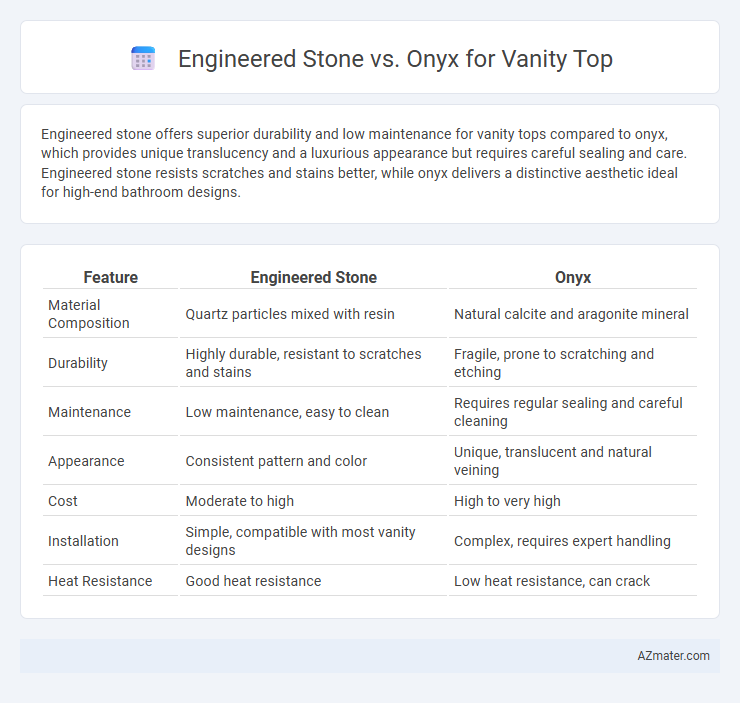Engineered stone offers superior durability and low maintenance for vanity tops compared to onyx, which provides unique translucency and a luxurious appearance but requires careful sealing and care. Engineered stone resists scratches and stains better, while onyx delivers a distinctive aesthetic ideal for high-end bathroom designs.
Table of Comparison
| Feature | Engineered Stone | Onyx |
|---|---|---|
| Material Composition | Quartz particles mixed with resin | Natural calcite and aragonite mineral |
| Durability | Highly durable, resistant to scratches and stains | Fragile, prone to scratching and etching |
| Maintenance | Low maintenance, easy to clean | Requires regular sealing and careful cleaning |
| Appearance | Consistent pattern and color | Unique, translucent and natural veining |
| Cost | Moderate to high | High to very high |
| Installation | Simple, compatible with most vanity designs | Complex, requires expert handling |
| Heat Resistance | Good heat resistance | Low heat resistance, can crack |
Introduction to Engineered Stone and Onyx Vanity Tops
Engineered stone vanity tops combine crushed quartz or natural minerals with resin binders, offering exceptional durability, stain resistance, and a low-maintenance surface ideal for bathrooms. Onyx vanity tops showcase stunning translucent beauty with unique veining patterns, creating a luxurious and elegant focal point, though they require more careful handling due to their softer, more porous nature. Both materials provide distinct aesthetic and functional advantages, making the choice dependent on the balance between durability and visual appeal desired in bathroom design.
Material Composition and Manufacturing Process
Engineered stone for vanity tops consists of crushed natural quartz bound with resin and pigment, resulting in a durable, non-porous surface with consistent color and pattern. Onyx is a natural sedimentary gemstone primarily made of calcite or aragonite, renowned for its translucency and unique veining but requiring sealing due to its porous and softer nature. Engineered stone undergoes a controlled manufacturing process involving mixing, vibration, pressing, and curing, ensuring uniformity and strength, while onyx slabs are cut and polished from natural deposits, maintaining organic variations but demanding more maintenance.
Aesthetic Appeal and Color Options
Engineered stone offers a wide range of color options with consistent patterns and a smooth, polished finish, ideal for achieving a modern and uniform aesthetic appeal on vanity tops. Onyx, prized for its translucent quality and unique natural veining, provides a luxurious and dramatic look that cannot be replicated by engineered materials. While engineered stone excels in durability and customization, onyx stands out for its vibrant, glowing colors that create an elegant and eye-catching centerpiece in any bathroom design.
Durability and Resistance to Damage
Engineered stone offers superior durability and resistance to scratches, stains, and heat, making it ideal for high-traffic vanity tops. Onyx, while visually striking with its unique translucence, is softer and more prone to etching, chipping, and damage from acidic substances. For long-lasting vanity surfaces that maintain their integrity under daily use, engineered stone is a more practical choice compared to the delicate nature of onyx.
Maintenance and Cleaning Requirements
Engineered stone offers low-maintenance benefits, requiring only mild soap and water to keep its non-porous surface free from stains and bacteria, making it ideal for busy bathrooms. Onyx, however, demands more careful maintenance due to its natural porous structure, necessitating frequent sealing and cautious cleaning with pH-neutral cleaners to prevent etching and discoloration. Regular upkeep of onyx is essential to preserve its luxurious appearance, whereas engineered stone provides durable, hassle-free care with minimal effort.
Cost Comparison and Budget Considerations
Engineered stone generally costs between $50 to $100 per square foot, offering a durable and budget-friendly option for vanity tops compared to onyx, which ranges from $75 to $250 per square foot due to its rarity and unique appearance. Maintenance costs for onyx are higher because it is softer and more prone to scratches and staining, requiring special sealants and care products. Budget considerations favor engineered stone for long-term affordability without sacrificing aesthetics, while onyx suits high-end projects where visual impact takes precedence over cost efficiency.
Installation Process and Complexity
Engineered stone vanity tops offer straightforward installation due to their uniform thickness and pre-fabricated slabs, simplifying cutting and fitting processes. Onyx, being a natural stone with varying translucency and fragility, requires specialized handling and skilled artisans to prevent cracking and ensure proper sealing during installation. The complexity of installing onyx leads to longer labor time and increased costs compared to the more standardized engineered stone options.
Environmental Impact and Sustainability
Engineered stone offers a more sustainable option for vanity tops due to its use of recycled materials and lower quarrying impacts compared to natural onyx, which requires intensive mining and generates significant waste. Engineered stone's durability extends the lifespan of vanity tops, reducing the frequency of replacement and resource consumption. Onyx, while aesthetically unique, often involves higher environmental costs because of its limited availability and energy-intensive extraction processes.
Pros and Cons of Engineered Stone Vanity Tops
Engineered stone vanity tops offer superior durability, resistance to stains, and low maintenance compared to natural onyx, making them ideal for high-traffic bathroom areas. However, engineered stone lacks the unique translucency and luxurious veining of onyx, which provides a more visually striking and elegant appearance. While engineered stone is more cost-effective and less prone to scratching and etching, it cannot fully replicate the natural beauty and exclusivity of an onyx vanity top.
Pros and Cons of Onyx Vanity Tops
Onyx vanity tops offer a unique, luxurious appearance with their translucent qualities and rich color variations, creating a striking focal point in bathroom design. However, onyx is softer and more porous than engineered stone, making it prone to scratching, staining, and etching from acidic substances, which requires regular sealing and careful maintenance. Despite its elegance, onyx is less durable and more expensive than engineered stone, limiting its practicality for high-traffic or heavy-use bathroom areas.

Infographic: Engineered stone vs Onyx for Vanity Top
 azmater.com
azmater.com